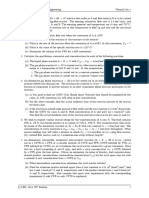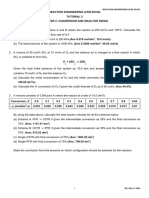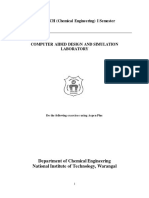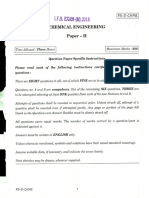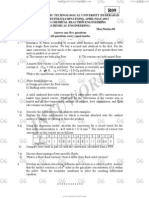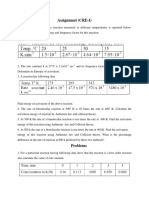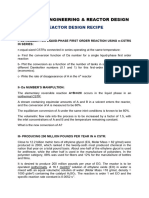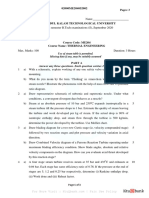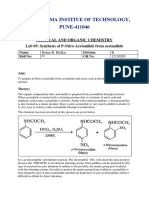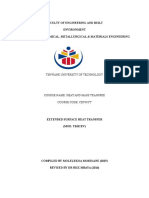TALY
TALY
Uploaded by
Jose David D SCopyright:
Available Formats
TALY
TALY
Uploaded by
Jose David D SCopyright
Available Formats
Share this document
Did you find this document useful?
Is this content inappropriate?
Copyright:
Available Formats
TALY
TALY
Uploaded by
Jose David D SCopyright:
Available Formats
2) The productiion of ethylene glicol from ethylene chlorohydrin and sodium bicarbonate.
( Is carried out in a semibatch reactor. A 1.5 molar solution of ethylene chlorohydrin is fed at a rate 0.1 mole/minute to 1500 of a 0.75 molar solution of sodium bicarbonate. The reaction is elemtary and carried out isothermally at 30C where the specific reaction rate is 5.1 Higher temperatures produce unwanted side reactions. The reactor can hold a maximum of 2500 of liquid. Assume constant density.
(a) (b)
Plot the conversion, reaction rate , concentration of reactants and products, and number of moles of glycol formed as a function of time. Suppose you vary the flow rate between 0.01 and 2 mol/min , what flow a rate would and holding time you choose to make the greatest number of moles of ethylene glycol in 24 hours keeping in mind the downtimes for cleaning, filling, etc. Shown in table 41. Suppose the ethylene chlorohydrin is fed rate of 0.15 mol/min until the reactor is full and the shut in. Plot the conversion a function of time. Discuss what you learned from this problem and what you believe to be the point of this problem.
(c) (d)
3) (Membrane reactor ) The first- order, reversible reaction.
AB+2C Is taking place in membrane reactor. Pure A enters the reactor, and B diffuses through the membrane. Unofortunately. Some of the reactant A also diffuse through the membrane. (a) Plot the flow rates of A,B and C down the reactor , as well as the flow rates of A and B through the membrane. (b) Compare the conversion profiles of a conventional PFR with those of an IMRCF. What generalizations can you make. (c) Would the conversion of A be greater or smaller if C were diffusing out instead of B? (d) Discuss how your curves would change if the temperature were increased significantly or decreased significantly for an exothermic reaction and for an endothermic reaction.
Additional Information: K=10
4) A micro reactor similar to the shown in figure P4-19 from the MIT group is used to produce phosgene in the gas phase.
A+B-C The microreactor is 20 mm long. 500 m in diameter, and packed with catalyst particles 35 m in diameter. The entering pressure is 830kPa (8,2 atm).and the entering flow to each microreactor is equimolar. The molar flow rate of CO is 2 x mol/s and the volumetric flow is 2.83 x . the weight of catalyst in microreactor W=3.5 . The reactor is kept isothermal at 120C. Because the catalyst is also slightly difeferent than the one in rate law is different as wel:
(a) Plot the molar flow rates and . The conversion X and pressure ratio y along the length of the reactor. (b) Calculi the number of microreactors in parallel to produce 10000 kg/tear phosgene. (c) Repeat part (a) for the case when the catalyst weight remains the same but particle diameter is cut in half. If possible compare your answer with part(a) and describe what you find noting anything unusual. (d) How would your answers to part (a) change if the reaction were reversible with Describe what you find. (e) What are the advantages and disadvantages of using an array of mi reactors over using one conventional packed bed reactor that provides same yield and conversion? (f) Write a question that involves critical thinking and explain wh involves critical thinking. (g) Discuss what you leamed from this problem and what you believe to the point of the problem.
Additional information Datos : = 3.55 K=0.004 catalyst ( bases on properties of air and =0.4) . s . Kg catalyst 120c , p=7kg/m =1.94 .
You might also like
- Tutorial 11Document5 pagesTutorial 11Aakash R RajwaniNo ratings yet
- Cre P.SDocument4 pagesCre P.SJanine ImeeNo ratings yet
- Chemical Reaction Engineering IDocument42 pagesChemical Reaction Engineering IMuthu UmayalNo ratings yet
- O Level Biology Practice Questions And Answers EnzymesFrom EverandO Level Biology Practice Questions And Answers EnzymesRating: 5 out of 5 stars5/5 (1)
- To Determine The Specific Heat Capacity of Solid and Liquid by Method of MixturesDocument5 pagesTo Determine The Specific Heat Capacity of Solid and Liquid by Method of MixturesVikash Kumar Singh0% (4)
- Taller de Diseño de ReactoresDocument9 pagesTaller de Diseño de ReactoresYeison Castellar TorresNo ratings yet
- Cro Tut8Document13 pagesCro Tut8Ernst SmitNo ratings yet
- Ch4-E - Fogler-4th Ed PDFDocument16 pagesCh4-E - Fogler-4th Ed PDFsandra thalia parmithaNo ratings yet
- R05320802chemicalreactionengineeringiiDocument8 pagesR05320802chemicalreactionengineeringiiSanthosh KumarNo ratings yet
- Department of Chemical Engineering, Iit Delhi Reactor Sizing Problems Assignment-2Document2 pagesDepartment of Chemical Engineering, Iit Delhi Reactor Sizing Problems Assignment-2ShubhamGuptaNo ratings yet
- Revision QuestionsDocument12 pagesRevision QuestionsLiew Wen Xuan0% (2)
- DQE January 2001: Additional InformationDocument12 pagesDQE January 2001: Additional InformationryezhuNo ratings yet
- Tut1 2016 QDocument5 pagesTut1 2016 QAbhishek SardaNo ratings yet
- JAB-TALLER 3er PARCIAL IRQ-2020-1Document5 pagesJAB-TALLER 3er PARCIAL IRQ-2020-1JESSICA PAOLA TORO VASCONo ratings yet
- HomeworkDocument3 pagesHomeworkJudluzNo ratings yet
- Classroom Exercise ProblemsDocument4 pagesClassroom Exercise Problemssarahvamp14No ratings yet
- Tutorial 2 QuestionDocument3 pagesTutorial 2 Questionnur hidayatiNo ratings yet
- 1415 Exam 1 (ICP) (EN)Document5 pages1415 Exam 1 (ICP) (EN)김하은No ratings yet
- Tutorial 4Document3 pagesTutorial 4EreenNo ratings yet
- CHP 482 - TutorialsDocument4 pagesCHP 482 - Tutorialsgeofrey oburuNo ratings yet
- IV B. TECH (Chemical Engineering) I SemesterDocument14 pagesIV B. TECH (Chemical Engineering) I SemesterPiyush AmbulgekarNo ratings yet
- Tutorial 5drtuhDocument2 pagesTutorial 5drtuhFikrie MuhdNo ratings yet
- Exercise TRK 1Document14 pagesExercise TRK 1Ananda CahyaNo ratings yet
- Dibutyl PhthalateDocument1 pageDibutyl PhthalatebebsybiswezNo ratings yet
- 838 PDFDocument8 pages838 PDFAravind KumarNo ratings yet
- Modul 3Document3 pagesModul 3Anonymous OecsqTANo ratings yet
- False) (1) (D) Justify: To Carry Out The Reaction More Important Than in Series Reactions " (3) (E) Define Turnover FrequencyDocument2 pagesFalse) (1) (D) Justify: To Carry Out The Reaction More Important Than in Series Reactions " (3) (E) Define Turnover FrequencyThe ultimate MemerNo ratings yet
- Cre-II EndtermDocument2 pagesCre-II Endtermbt21cme061No ratings yet
- Tutorial QuestionsDocument8 pagesTutorial QuestionsMaame Efua Neizer100% (1)
- Chem Engg Paper-IIDocument6 pagesChem Engg Paper-IIambaneh tzeraNo ratings yet
- Set A Final Exam QuestionDocument8 pagesSet A Final Exam QuestionDhayalan RamachandranNo ratings yet
- Tutorial For Chapter 23Document9 pagesTutorial For Chapter 23Thurgah VshinyNo ratings yet
- Advanced Chemical Reaction EngineeringDocument1 pageAdvanced Chemical Reaction EngineeringIbmWasuserNo ratings yet
- CRE IdocxDocument8 pagesCRE IdocxParth DesaiNo ratings yet
- CHE3044F, 2013: Reactor Design 1: TUTORIAL 6Document4 pagesCHE3044F, 2013: Reactor Design 1: TUTORIAL 6nmhatityeNo ratings yet
- S4 Thermodynamics PQPDocument16 pagesS4 Thermodynamics PQPAltros mNo ratings yet
- Tutorial-3 CRE1 CLL122 PDFDocument4 pagesTutorial-3 CRE1 CLL122 PDFSunandita BorahNo ratings yet
- Ideal Reactors Part 1 Solved ProblemsDocument18 pagesIdeal Reactors Part 1 Solved Problemsalismart1382No ratings yet
- Reactor EnggDocument75 pagesReactor EnggarunperthNo ratings yet
- Zaineb I-Clicker.1.2Document18 pagesZaineb I-Clicker.1.2زينب فرجNo ratings yet
- 4 - Reactor Design RecipeDocument4 pages4 - Reactor Design RecipeRemi ESBERNo ratings yet
- Mech-Engg., Thermal EngineeringDocument8 pagesMech-Engg., Thermal Engineeringnims1964No ratings yet
- CHE 140A Problem Set No. 8: Hill, 4-1, Pg. 120Document3 pagesCHE 140A Problem Set No. 8: Hill, 4-1, Pg. 120Anthony RoqueNo ratings yet
- Worksheet On CH TWODocument3 pagesWorksheet On CH TWOfikadubiruk87No ratings yet
- Unsw Sydney School of Chemical Engineering Sample Paper Ceic 2005 Chemical Reaction EngineeringDocument6 pagesUnsw Sydney School of Chemical Engineering Sample Paper Ceic 2005 Chemical Reaction EngineeringJoshua JohnNo ratings yet
- ECH3707 Worksheets Multiple ReactionDocument5 pagesECH3707 Worksheets Multiple ReactionNyanNo ratings yet
- Past Paper UoEDocument2 pagesPast Paper UoEClément JacquesNo ratings yet
- 2017 AdvancesDocument8 pages2017 AdvancesAkshai Ashok KumarNo ratings yet
- EgyE 201 Assignment On Energy Conversion SystemsDocument2 pagesEgyE 201 Assignment On Energy Conversion SystemsAngel de DiosNo ratings yet
- Saint Louis University: Chemical Engineering PrinciplesDocument6 pagesSaint Louis University: Chemical Engineering PrinciplesAileen MayaNo ratings yet
- ExercisesDocument13 pagesExercisesRajpriya GuptaNo ratings yet
- 2020 09 23SupplementaryME204ME204 H Ktu QbankDocument3 pages2020 09 23SupplementaryME204ME204 H Ktu QbankamaljyothyrajNo ratings yet
- TY Btech CH Chemical Reaction Engineering SEM-V JAN 2024Document3 pagesTY Btech CH Chemical Reaction Engineering SEM-V JAN 2024KUNAL SHINDENo ratings yet
- CL324 - 2023 - Tutorial 02Document2 pagesCL324 - 2023 - Tutorial 02Prince KumarNo ratings yet
- Introduction To Chemical Reactor Engineering - Problems PDFDocument75 pagesIntroduction To Chemical Reactor Engineering - Problems PDFJojie-Ann Alabarca100% (1)
- Flow Reactors Assignment Problems 5 6Document1 pageFlow Reactors Assignment Problems 5 6DechenPemaNo ratings yet
- Chemical Reactors - Problems of Reactor Association 47-60: (Exam Jan'09)Document6 pagesChemical Reactors - Problems of Reactor Association 47-60: (Exam Jan'09)Alfredo ZuñigaNo ratings yet
- A Modern Course in Statistical PhysicsFrom EverandA Modern Course in Statistical PhysicsRating: 3.5 out of 5 stars3.5/5 (2)
- Biofilms in Bioelectrochemical Systems: From Laboratory Practice to Data InterpretationFrom EverandBiofilms in Bioelectrochemical Systems: From Laboratory Practice to Data InterpretationNo ratings yet
- Sustainable and Green Electrochemical Science and TechnologyFrom EverandSustainable and Green Electrochemical Science and TechnologyNo ratings yet
- (Surfactant Science) Fernando V Molina-Soil Colloids - Properties and Ion Binding-Taylor & Francis, CRC Press (2013) PDFDocument535 pages(Surfactant Science) Fernando V Molina-Soil Colloids - Properties and Ion Binding-Taylor & Francis, CRC Press (2013) PDFBrajhan Espiritu100% (1)
- Soalan Tambahan Modul 2.1 & 2.2 HazriqDocument4 pagesSoalan Tambahan Modul 2.1 & 2.2 HazriqMuhammad Hazriq Bin ArisNo ratings yet
- Sample Exercise 5.1: SolutionDocument26 pagesSample Exercise 5.1: SolutionArvie Karl NabiNo ratings yet
- GailDocument21 pagesGailVishal Kumar JhaNo ratings yet
- Condensed Matter Physics - NotesDocument7 pagesCondensed Matter Physics - NotesBs PhysicsNo ratings yet
- Science 7 1st Quarter ExamDocument2 pagesScience 7 1st Quarter ExamLeslie Quingco100% (3)
- 05 Rohan Bhilkar POAC LAB 05Document3 pages05 Rohan Bhilkar POAC LAB 05Rohan BhilkarNo ratings yet
- Thermodynamics DPP-7Document3 pagesThermodynamics DPP-7shubhamauddhyaNo ratings yet
- COAS C1 05 Acts msws2Document2 pagesCOAS C1 05 Acts msws2Eses SNo ratings yet
- 10 Science NcertSolutions Chapter 4 Intext Page 61Document1 page10 Science NcertSolutions Chapter 4 Intext Page 61apfc epfoNo ratings yet
- Buffers&titrationsquestions ReviewDocument6 pagesBuffers&titrationsquestions Reviewapi-279595789No ratings yet
- 2016 Heat and Mass Transfer Practical ManualDocument8 pages2016 Heat and Mass Transfer Practical ManualPortia ShilengeNo ratings yet
- CHE 1000 Lecture Notes - ThermochemistryDocument39 pagesCHE 1000 Lecture Notes - ThermochemistryNathan MulunguNo ratings yet
- The MICROREACTOR A Systematic and Efficient ToolDocument7 pagesThe MICROREACTOR A Systematic and Efficient Tooljulianque81574No ratings yet
- Use of A Pulsed High-Voltage Discharge For Removal of Organic Compounds in Aqueous SolutionDocument8 pagesUse of A Pulsed High-Voltage Discharge For Removal of Organic Compounds in Aqueous SolutionEngr Syed Numan ShahNo ratings yet
- Organic Chemistry For IGCSE ChemistryDocument4 pagesOrganic Chemistry For IGCSE Chemistrydanielmahsa100% (2)
- 1st Puc Chemistry Fix QuestionsDocument4 pages1st Puc Chemistry Fix QuestionserannakalivalNo ratings yet
- Atomic Structure-Objective QuestionsDocument20 pagesAtomic Structure-Objective QuestionsNitin SharmaNo ratings yet
- Brief Introduction To Distillation Control: 3 Main ObjectivesDocument10 pagesBrief Introduction To Distillation Control: 3 Main Objectiveslovsid100% (1)
- A A Study of F Asphalt Tene Cont Tent of in Ndonesian N Heavy O OilDocument9 pagesA A Study of F Asphalt Tene Cont Tent of in Ndonesian N Heavy O OilArif MokhtarNo ratings yet
- 1 s2.0 S002236971100240X MainDocument9 pages1 s2.0 S002236971100240X MainDattatreya PatiNo ratings yet
- Similarity Solution of Heat and Mass Transfer For The Falling Film Flow On A Porous Medium in Presence of Heat Generation or AbsorptionDocument7 pagesSimilarity Solution of Heat and Mass Transfer For The Falling Film Flow On A Porous Medium in Presence of Heat Generation or Absorptioncemal gümrükçüoğluNo ratings yet
- Multiple Stagesddd LLEDocument6 pagesMultiple Stagesddd LLEFikrie MuhdNo ratings yet
- Solubility RulesDocument3 pagesSolubility RulestiraNo ratings yet
- Whats in A Tums - Stoichiometry Acceleration LabDocument3 pagesWhats in A Tums - Stoichiometry Acceleration Labapi-645795047No ratings yet
- Determining The Molar Concentration of Vinegar by TitrationDocument18 pagesDetermining The Molar Concentration of Vinegar by TitrationYasinaNo ratings yet
- Shell and Tube Heat ExchangerDocument112 pagesShell and Tube Heat Exchangerramesh pokhrel100% (3)
- Arrhenius Equation - WikipediaDocument25 pagesArrhenius Equation - Wikipediatirth_diwaniNo ratings yet
- Answers To End-Of-Chapter Questions For Chapter 11, ElectrolysisDocument2 pagesAnswers To End-Of-Chapter Questions For Chapter 11, ElectrolysisAliNo ratings yet












